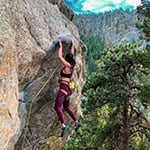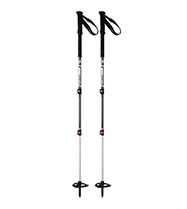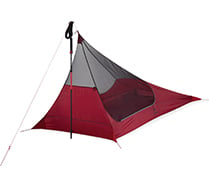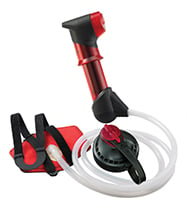Crag Dogs: A Climber’s Best Friend (Or Worst Enemy)
When you punt off your project for the hundredth time in a row, having your dog at the crag with you can spell the difference between holding it together and bursting into tears. But it’s a double-edged sword. If you’re going for the send on your project and your crag dog spots a wild animal they want to chase, you need to stop, go in-direct or lower and handle your crag dog. Whether dogs belong at the crag is a difficult question with many different answers, and they may all be right. We’re here to help you make the right decision for yourself and your dog.

Rules and Regulations
It doesn’t matter if your dog is the best crag dog in the world, if the area’s regulations say no dogs—sorry puppy, you stay home today. A quick Google search will tell you what land you’re recreating on, and what policies are in place. The regulations are there for a reason; Wildlife Management Areas must prioritize wildlife, and National Conservation Areas are there to conserve the ecosystem for future generations. Heed to regulations; don’t be that person.
Some climbing areas may have special considerations. For example, the desert’s delicate ecosystem may not be suitable for dogs no matter how well-behaved they are. Crag dogs can’t identify cryptobiotic soil on the approach and avoid stepping on it as you can. Check the front matter of your guidebooks, as this information is often listed there.

Training Crag Dogs
It is not the responsibility of other climbers at the crag to handle your dog. Last week at a crag, a stranger’s dog wandered by and sat on the rope (I can understand, it’s the softest spot) while I was belaying. The owner yelled from a few routes over, “Just tell my puppy to leave it!” Your dog training is your responsibility.
- Make sure your dog always heeds your verbal commands like come, stay and leave it.
- Make sure your dog can handle being leashed, potentially at all times.
- If your dog is aggressive towards other dogs or humans, leave it at home.
Safety and Gear
Once you’ve determined that bringing your dog is acceptable, make sure to keep them safe and comfortable!
Make sure to bring plenty of water and snacks for your dog. If there is a water source nearby, bring a water filter to ensure they (and yourself) are well hydrated. Don’t let your dog drink from a pond of stagnant water!
Research the area you’re visiting. Is dangerous wildlife like rattlesnakes or poisonous plants present? If they are, consider keeping your crag dog on a leash at all times, even if regulations allow them to be off-leash. What’s the approach like? What’s the staging area like? Is it flat and safe, or is it rocky and cliff-side? Approaches that involve scrambling, difficult 3rd class, or easy 4th class terrain may not be the best crags for your dog to visit. Have first-aid supplies for yourself and your pup—better safe than sorry.
For the comfort of your dog, bring a lightweight sleeping pad they can lay on, and a camp blanket or additional layers for them on brisk days. Keep in mind that you might be shedding layers as you climb, but your pup may not be staying as active as you are. Pads or small beds often help dogs be content when leashed up.
Pay special consideration to paw care. Consider booties if walking rocky or snowy trails. This blog on backpacking with dogs is a useful resource; many tips listed there are transferable to crag dogs!
Crag Etiquette
You wouldn’t hog the classic climb all day with a top rope, and you wouldn’t let your crag dog riffle through someone’s pack; dog etiquette is crag etiquette. If there are no land restrictions, and your crag dog is well-trained, make sure you’re following some rules of common decency.
- Noise: Dogs bark, that is understandable. Whether they’re being vocal because someone new is approaching the crag or because you (the one they love the most) is climbing out of sight, make sure you can keep the noise to a minimum. Keep plenty of treats or toys on hand as a distraction, be ready to comfort your dog, and assure them the new climber is not a threat.
- Mind the Gear: Make sure your dog stays out of your and other climbers’ ropes, crash pads, crag packs and belongings. A friend had the unfortunate experience of someone else’s dog peeing on her jacket. For the safety of climbers and crag dogs alike, make sure they stay out of landing zones too. This might mean leashing your dog or making sure someone in your party is ready to take on crag dog duty whenever they are not climbing, belaying or spotting.
- Leave No Trace: This one is self-explanatory. Pick up after your dog, don’t let them dig holes, disturb wildlife or uproot the tree/shrub they’re leashed to.
Keep in mind that not everyone feels the same way about dogs. If you bring your dog to the crag, have a plan B ready; if things don’t go as planned, be ready to choose a different crag or leave the climb for another day. We have bad days, dogs do too.
Related Posts:
- Backcountry Dog Etiquette Tips for Winter
- Eric Larsen on Dog Sledding, the Team Dynamic & Running with Your Best Friends
- Strength Training for Climbers: 3 Tips from Steph Davis
 Holly Yu Tung Chen
Holly Yu Tung Chen
Holly is a Taiwanese climber, route setter and writer based in Denver, Colorado. Inspired by desert towers and a good summit snack, Holly is a yes-woman to anything climbing-related. Her number one goal is to look for authentic, genuine stories, especially stories of people who don’t like those already there.






